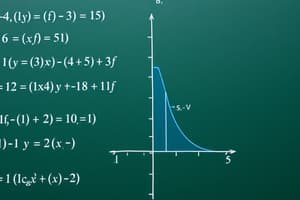Podcast
Questions and Answers
What is defined as the set of all possible output values that a function can produce?
What is defined as the set of all possible output values that a function can produce?
Which type of function ensures that each output is produced by exactly one input?
Which type of function ensures that each output is produced by exactly one input?
Which of the following statements accurately describes an odd function?
Which of the following statements accurately describes an odd function?
What does the vertical asymptote of a function indicate?
What does the vertical asymptote of a function indicate?
In function composition f(g(x)), what is g(x) referred to?
In function composition f(g(x)), what is g(x) referred to?
Which of the following accurately defines a continuous function?
Which of the following accurately defines a continuous function?
What describes the y-intercept of a function?
What describes the y-intercept of a function?
What do increasing intervals of a function indicate about its graph?
What do increasing intervals of a function indicate about its graph?
Which characteristic distinguishes a quadratic function from a linear function?
Which characteristic distinguishes a quadratic function from a linear function?
What does the vertical line test help to determine?
What does the vertical line test help to determine?
Which function type has the general form f(x) = ax³ + bx² + cx + d?
Which function type has the general form f(x) = ax³ + bx² + cx + d?
What does a rational function typically exclude from its domain?
What does a rational function typically exclude from its domain?
Which of the following equations represents an absolute value function?
Which of the following equations represents an absolute value function?
Which form does a linear function take?
Which form does a linear function take?
What shape does the graph of a quadratic function typically take?
What shape does the graph of a quadratic function typically take?
In a polynomial function of the form f(x) = a_n x^n + a_(n-1)x^(n-1) + ... + a_1x + a_0, what determines the shape of the graph?
In a polynomial function of the form f(x) = a_n x^n + a_(n-1)x^(n-1) + ... + a_1x + a_0, what determines the shape of the graph?
Flashcards are hidden until you start studying
Study Notes
Functions
Properties of Functions
- Definition: A function is a relation that assigns exactly one output for each input.
- Domain: The set of all possible input values (x-values) for a function.
- Range: The set of all possible output values (y-values) that a function can produce.
- One-to-One Function: A function where each output is produced by exactly one input; no y-value is repeated.
- Onto Function: A function where every element in the codomain is mapped to by at least one element from the domain.
- Inverse Function: A function that reverses the effect of the original function; denoted as f⁻¹(x).
- Composition of Functions: Combining two functions where the output of one function becomes the input of another; denoted as (f ∘ g)(x) = f(g(x)).
- Even Function: A function that satisfies f(-x) = f(x) for all x in its domain; symmetric about the y-axis.
- Odd Function: A function that satisfies f(-x) = -f(x) for all x in its domain; symmetric about the origin.
Graphing Functions
- Coordinate System: Uses Cartesian coordinates (x, y) to plot functions.
- Plotting Points: Identify key points by substituting x-values into the function to find corresponding y-values.
- Intercepts:
- X-intercept: The point(s) where the graph crosses the x-axis (y=0).
- Y-intercept: The point where the graph crosses the y-axis (x=0).
- Asymptotes: Lines that the graph approaches but never touches:
- Vertical Asymptotes: Occur where the function is undefined (denominator = 0).
- Horizontal Asymptotes: Describe the behavior of the function as x approaches infinity (y approaches a constant).
- Increasing/Decreasing Intervals: Identify where the function rises (increasing) or falls (decreasing) based on the slope of the graph.
- Continuity: A function is continuous if its graph can be drawn without lifting the pencil; no breaks, jumps, or holes.
- End Behavior: Describes how the function behaves as x approaches positive or negative infinity; relevant for polynomial functions.
- Transformation: Functions can undergo transformations, including:
- Translation: Shifting the graph horizontally or vertically.
- Reflection: Flipping the graph over a line (usually the x-axis or y-axis).
- Stretching/Shrinking: Changing the steepness of the graph by multiplying the function by a constant.
Properties of Functions
- A function maps each input to exactly one output, defining a unique relationship between variables.
- The domain includes all permissible x-values that a function can accept.
- The range comprises all possible y-values that the function can generate from its domain.
- A one-to-one function produces unique outputs for each input, ensuring no y-value is repeated.
- An onto function guarantees that every element in the codomain corresponds to at least one input from the domain.
- An inverse function reverses the original function's effect, represented as f⁻¹(x), allowing for the retrieval of the original input from the output.
- Function composition combines two functions, where the output from one becomes the input of another, expressed as (f ∘ g)(x) = f(g(x)).
- An even function exhibits symmetry about the y-axis, as it satisfies the condition f(-x) = f(x).
- An odd function is symmetric about the origin, fulfilling f(-x) = -f(x).
Graphing Functions
- The Cartesian coordinate system plots functions using pairs of values (x,y).
- Plotting points involves substituting x-values into the function to find corresponding y-values for accurate graph representation.
- Intercepts are crucial for understanding graph behavior:
- X-intercept: The graph's points where y equals zero; crossings along the x-axis.
- Y-intercept: The graph's point where x equals zero; crossing along the y-axis.
- Asymptotes indicate lines approached by the graph, which the function does not touch:
- Vertical asymptotes occur when the function becomes undefined due to a zero denominator.
- Horizontal asymptotes represent the function's behavior as x approaches infinity, stabilizing at a constant y-value.
- Increasing and decreasing intervals analyze where a function rises or falls using slope data from the graph.
- A function is deemed continuous if it can be graphed without interruptions; there are no gaps or discontinuities.
- End behavior describes a function’s tendency as x moves towards positive or negative infinity, particularly relevant for polynomials.
- Functions can be transformed through various methods:
- Translation involves shifting the graph either horizontally or vertically.
- Reflection flips the graph over a specific axis, such as the x-axis or y-axis.
- Stretching or shrinking modifies the graph's steepness by multiplying the function by a constant factor.
Definition and Notation
- A function is defined as a relation in which each input (x) corresponds to exactly one output (y).
- Common notations for functions include f(x), g(x), etc.
Types of Functions
-
Linear Functions:
- General form: f(x) = mx + b; m represents the slope, and b indicates the y-intercept.
- Graphically represented as a straight line.
-
Quadratic Functions:
- General form: f(x) = ax² + bx + c, where a ≠ 0.
- Parabola shape, which can open upwards or downwards depending on the sign of a.
-
Cubic Functions:
- General form: f(x) = ax³ + bx² + cx + d.
- Graphs can have one or two turns, exhibiting more complex behavior than linear or quadratic functions.
-
Polynomial Functions:
- General form: f(x) = a_n x^n + a_(n-1)x^(n-1) + ... + a_1x + a_0.
- The degree (highest exponent n) significantly influences the function's shape and characteristics.
-
Rational Functions:
- General form: f(x) = P(x)/Q(x), where P and Q are polynomials.
- Domain excludes values that cause Q(x) to equal zero, indicating undefined points.
Identifying Functions
-
Vertical Line Test:
- A graphical method to determine if a curve represents a function; if a vertical line intersects the graph at more than one point, it is not a function.
-
Mapping Diagrams:
- Visual representations that show the relationship between inputs and outputs, ensuring that each input has only one output.
Common Characteristics
- Domain: The complete set of possible values for input (x).
- Range: The complete set of possible values for output (y).
Special Functions
- Absolute Value Functions: Represented as f(x) = |x|, creating a V-shaped graph.
- Exponential Functions: Formulated as f(x) = a * b^x, used for modeling growth and decay processes.
- Logarithmic Functions: Defined as f(x) = log_b(x), serving as the inverse operation of exponential functions.
Key Points to Remember
- Functions are distinguished based on their algebraic forms and characteristics.
- Proper identification of functions involves analyzing their graphs through methods like the vertical line test.
- A solid understanding of domain and range is essential for effective function analysis.
Studying That Suits You
Use AI to generate personalized quizzes and flashcards to suit your learning preferences.




